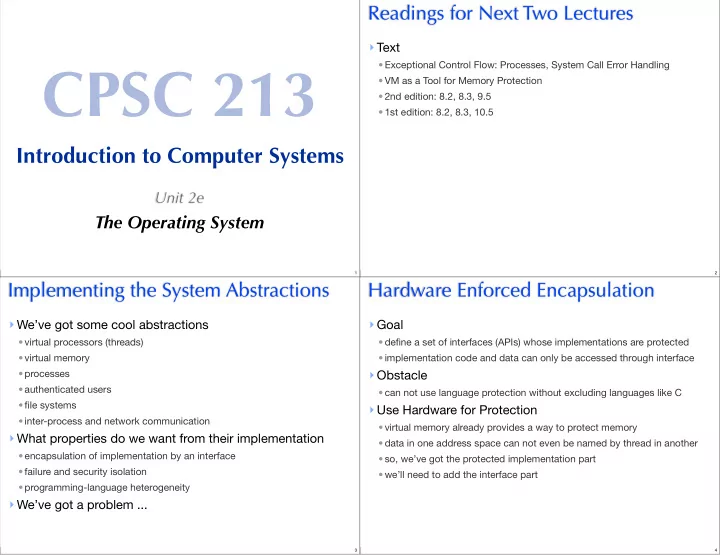

Readings for Next Two Lectures ‣ Text CPSC 213 •Exceptional Control Flow: Processes, System Call Error Handling •VM as a Tool for Memory Protection •2nd edition: 8.2, 8.3, 9.5 •1st edition: 8.2, 8.3, 10.5 Introduction to Computer Systems Unit 2e The Operating System 1 2 Implementing the System Abstractions Hardware Enforced Encapsulation ‣ We’ve got some cool abstractions ‣ Goal •virtual processors (threads) •define a set of interfaces (APIs) whose implementations are protected •virtual memory •implementation code and data can only be accessed through interface ‣ Obstacle •processes •authenticated users •can not use language protection without excluding languages like C •file systems ‣ Use Hardware for Protection •inter-process and network communication •virtual memory already provides a way to protect memory ‣ What properties do we want from their implementation •data in one address space can not even be named by thread in another •encapsulation of implementation by an interface •so, we’ve got the protected implementation part •failure and security isolation •we’ll need to add the interface part •programming-language heterogeneity ‣ We’ve got a problem ... 3 4
The Operating System Implementing Hardware Encapsulation ‣ The operating system is ‣ Hardware • a C/assembly program •mode register (user or kernel) boolean isKernelMode; • implements a set of abstractions for applications •certain instructions only legal in kernel mode • it encapsulates the implementation of these abstractions, including hardware •page table entries have protection flag (user or kernel) ‣ The Operating System’s Address Space •attempting to access a kernel page while in user mode causes fault •special instructions for switching between user and kernel modes • a part of every application’s page table is reserved for the OS ‣ Translation • all code and data of OS is part of every page table (exact copies) class PageTableEntry { • and so the operating system is part of every application’s address space boolean isValid; boolean isKernel; ‣ Dual Protection Domains int pfn; int translate (int va) { } • each address space splits into application and system protection domain int vpn = va >>> 12; int offset = va & 0xfff; • CPU can run in one of two modes: user and kernel if (pte[vpn].isValid && (isKernelMode || !pte[vpn].isKernel)) return pte[vpn].pfn << 12 | offset; • when in user mode, the OS part of virtual memory is inaccessible else • when in kernel mode, all of virtual memory is accessible throw new IllegalAddressException (va); } 5 6 Protected Procedure Call ‣ Implementing Protected Call Instruction Two special hardware registers ‣ Switching from User Mode to Kernel Mode must be protected boolean isKernelMode • OS has a fixed set of “entry points”, its public API void (**systemCallTable)(); • an application can call any of these entry points, but no others Initialized at OS boot time • when in kernel mode the application can access anything • so, application can only switch to kernel mode after calling entry point isKernelMode = true; *systemCallTable = malloc (sizeof (void*) * MAX_SYS_CALL_NUM); • but, even entry points are in inaccessible memory systemCallTable[0] = syscall; ‣ Implementing Protected Calls systemCallTable[1] = exit; systemCallTable[2] = fork; • OS boot sets up entry-point jump table in kernel memory systemCallTable[3] = read; ... • jump table is indexed by system call number and stores procedure address • system call instruction changes mode and jumps through jump table Protected call instruction, assuming syscall number is in r0 • in IA32 this instruction is called “int 80” (i.e., interrupt number 0x80) sysCallNum = r[0]; • this works like an IO-Controller interrupt, it transfers control to interrupt-handler if (sysCallNum >= 0 && sysCallNum <= MAX_SYSCALL_NUM) { • but this also switches the processor into kernel mode (all interrupts do this) isKernelMode = true; pc = systemCallTable [sysCallNum]; } else movl $1, %eax # system call number (exit) throw new IllegalSystemCall (); int $0x80 # interrupt 80 is a system call IO-Controller interrupts revisited ... 7 8
Setting Up Other Protection Domains Summary ‣ Any application can be a protection domain ‣ Single System Image • hardware implements a set of instructions needed by compilers • we often call them “servers” or “daemons” • compilers translate programs into these instructions ‣ Encapsulation • translation assumes private memory and processor • the application’s address space is private ‣ Threads ‣ Public interface • an abstraction implemented by software to manage asynchrony and concurrency • implemented manually in application using message-passing • provides the illusion of single processor to applications • OS provides Inter-process Communication (IPC) interface (send/receive) • differs from processor in that it can be stopped and restarted • server sets up “communication endpoint” and waits to receive messages ‣ Virtual Memory • callers send messages to request the server to perform a protected function • an abstraction implemented by software and hardware • send/receive are system calls • provides the illusion of a single, private memory to application ‣ Calling a server • not all data need be in memory, paged in on demand ‣ Hardware Enforced Encapsulation • server calls receive, traps to the OS and blocks there • kernel mode register and VM mapping restriction • caller calls send, traps to OS • allows OS to export a public interface and to encapsulate (hide) the implementation • OS context switches to server, and unblocks server 9 10
Recommend
More recommend